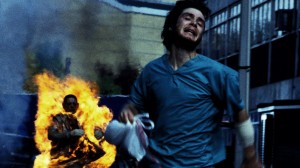28 DAYS LATER
 28 Days Later begins with a great horror movie premise. A group of British activists free infected animals from their cages, unleashing a deadly “rage” virus on the human population. Twenty-eight days after the virus took hold of the city, a bicycle courier named Jim awakens from a coma, unaware of the devastation. In one of the year’s best cinematic sequences, horror or otherwise, Jim leaves the hospital to find a deserted London. Director Danny Boyle (Trainspotting, Shallow Grave) infuses the shots of the empty streets with a sense of dread. As Jim wanders through the vacant Piccadilly Circus the feeling of foreboding grows as he realizes that something catastrophic has happened here. And that’s just the first ten minutes. (The scenes of London’s deserted streets were shot just after dawn on weekdays. Because of the traffic, they could only shoot for a couple of minutes each day. Crewmembers frequently had to stop and ask clubbers not to walk into shots.)
28 Days Later begins with a great horror movie premise. A group of British activists free infected animals from their cages, unleashing a deadly “rage” virus on the human population. Twenty-eight days after the virus took hold of the city, a bicycle courier named Jim awakens from a coma, unaware of the devastation. In one of the year’s best cinematic sequences, horror or otherwise, Jim leaves the hospital to find a deserted London. Director Danny Boyle (Trainspotting, Shallow Grave) infuses the shots of the empty streets with a sense of dread. As Jim wanders through the vacant Piccadilly Circus the feeling of foreboding grows as he realizes that something catastrophic has happened here. And that’s just the first ten minutes. (The scenes of London’s deserted streets were shot just after dawn on weekdays. Because of the traffic, they could only shoot for a couple of minutes each day. Crewmembers frequently had to stop and ask clubbers not to walk into shots.)
Boyle deftly juggles two distinct ideas in 28 Days Later. It is a full blown Halloween flick, complete with drooling angry zombies, (although hard-core gore fans will be disappointed, most of the horror here is psychological) but at its core it is also a compelling study of human nature and the will to survive. Each character is fully rounded, and none are superfluous in this tough drama.
Selena (Naomie Harris), for example, isn’t a damsel in distress, nor is she simply a hard-nosed zombie killer. She is a layered character, a normal person who is placed in an unimaginable circumstance and is dealing with it on an instinctual level. She isn’t a killer, but she’ll kill to survive. “Staying alive is as good as it gets,” she says grimly.
Boyle (and screenwriter Alex Garland) give a wide berth to the stereotypical character traits found in horror movies – the screaming girlfriend, the witless teen, the gung-ho monster slayer – and instead concentrate on developing believable characters and situations in an unbelievable scenario.
In addition to believable characters 28 Days Later also re-invents the cinematic zombie. Gone are the lumbering, “We’re coming to get you,” living dead from years past. Boyle’s ghouls move with frightening speed, hissing at the scent of human flesh, and attacking at random. These are the zombies that nightmares are made of.
Shooting on digital video this time out, Boyle has left behind the visual showiness of Trainspotting and the austere picture-postcard look of The Beach, trading those in for a grainy, almost documentary feel. The jagged feel of the video gives the movie a sense of urgency and energy which seems appropriate for the subject matter. Unlike Soderbergh’s Full Frontal this material actually benefits from the use of video.
28 Days Later runs out of steam as the third act winds down, but up until its closing minutes it is as good as speculative fiction gets.
Leave a Reply
You must be logged in to post a comment.
